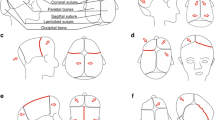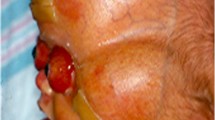Abstract
Introduction
There have been 23 previously published cases of patients with syndromic craniosynostosis and human tails. In many of these, the tail was composed of prominent coccygeal and sacral vertebrae, curved in a retroverted instead of in the normal anterograde fashion. This has been termed sacrococcygeal eversion. In those cases in which genetic testing results are reported, there were fibroblast growth factor receptor 2 (FGFR2) mutations.
Methods
We present three patients with Pfeiffer syndrome and sacrococcygeal eversion. Two had genetic testing and both had FGFR2 mutations, one of them a novel mutation in patients with syndromic craniosynostosis and sacrococcygeal eversion. We also briefly review the literature on craniosynostosis and human tails.
Results
All but one reported patient has had either Pfeiffer, Crouzon, or Beare-Stevenson syndrome. Most patients, including ours, have had severe manifestations of their syndrome. Although the pathogenesis of sacrococcygeal eversion is unknown, a similarly posteriorly curved tail bud develops in normal human embryos during the second month of gestation.
Conclusions
Perhaps increased FGFR2 activation during this embryonic period leads to abnormal differentiation or regression of the tail bud and, in turn, sacrococcygeal eversion, in certain patients with severe syndromic craniosynostosis.


Similar content being viewed by others
References
Gould GM, Pyle WL (1896) Anomalies and curiosities of medicine. Saunders, Philadelphia, pp 277–279
Harrison RG (1901) On the occurrence of tails in man, with a description of the case reported by Dr. Watson. Johns Hopkins Hosp Bull 12:96–101
Bartels M (1884) Die geschwanzten Menschen. Archiv Anthropol 15:45–132
Virchow R (1884) Tailed man. NY Med J 40:684
Wells TR, Falk RE, Senac MO, Vachon L (1990) Acrocephalospondylosyndactyly—a possible new syndrome: analysis of the vertebral and intervertebral components. Pediatr Pathol 10:117–131
Hall BD, Cadle RG, Golabi M, Morris CA, Cohen MM Jr (1992) Beare-Stevenson cutis gyrata syndrome. Am J Med Genet 44:82–89
Sagehashi N (1992) An infant with Crouzon’s syndrome with a cartilaginous trachea and a human tail. J Craniomaxillofac Surg 20:21–23
Moore MH, Lodge ML, Clark BE (1995) Spinal anomalies in Pfeiffer syndrome. Cleft Palate Craniofac J 32:251–254
Moore MH, Cantrell SB, Trott JA et al (1995) Pfeiffer syndrome: a clinical review. Cleft Palate Craniofac J 32:62–70
Ito S, Matsui K, Ohsaki E et al (1996) A cloverleaf skull syndrome probably of Beare-Stevenson type associated with Chiari malformation. Brain Devel 18:307–311
Przylepa KA, Paznekas W, Zhang M et al (1996) Fibroblast growth factor receptor 2 mutations in Beare-Stevenson cutis gyrata syndrome. Nat Genet 13:492–494
Krepelova A, Baxova A, Calda P, Plavka R, Kapras J (1998) FGFR2 gene mutation ((Tyr375Cys) in a new case of Beare-Stevenson syndrome. Am J Med Genet 76:362–364
S-h K, Elanko N, Johnson D et al (2002) Genomic screening of fibroblast growth-factor receptor 2 reveals a wide spectrum of mutations in patients with syndromic craniosynostosis. Am J Hum Genet 70:472–486
Sweeney E, Ellis I, May P (2002) Sacral appendage associated with a mutation in FGFR2. Clin Dysmorphol 11:221–222
Okajima K, Aoki I, Sagehashi N et al (2003) Three craniosynostotic patients with tracheal sleeve. Clin Dysmorphol 12:75
Gonzales M, Heuertz S, Matinovic J et al (2005) Vertebral anomalies and cartilaginous tracheal sleeve in three patients with Pfeiffer syndrome carrying the S351C FGFR2 mutation. Clin Genet 68:179–181
Lapunzina P, Fernandez A, Sanchez Romero JM, Delicado A, Saenz de Pipaon M, Lopez Pajares I, Molano J (2005) A novel insertion in the FGFR2 gene in a patient with Crouzon phenotype and sacrococcygeal tail. Birth Defects Res (Pat A) 73:61–64
Oliveira NAJ, Alonso LG, Fanganiello RD, Passos-Bueno MR (2006) Further evidence of association between mutations in FGFR2 and syndromic craniosynostosis with sacrococcygeal eversion. Birth Defects Res A Clin Mol Teratol 76:629–633
Lajeunie E, Heuertz S, El Ghouzzi V et al (2006) Mutation screening in patients with syndromic craniosynostoses indicates that a limited number of recurrent FGFR2 mutations accounts for severe forms of Pfeiffer syndrome. Eur J Hum Genet 14:289–298
McGaughran J, Sinnott S, Susman R et al (2006) A case of Beare-Stevenson syndrome with a broad spectrum of features and a review of the FGFR2 Y375C mutation phenotype. Clin Dysmorphol 14:89–93
Akai T, Yamamoto K, Iizuka H et al (2006) Syndromic craniosynostosis with elbow joint contracture. Pediatr Neurosurg 42:108–112
Lai AHM, Tan Y-M, Law H-Y, Yeow VKL (2008) A mutation in FGFR2 in a child with Pfeiffer syndrome and a sacral appendage. Clin Dysmorphol 17:73–74
Eun S-H, Ha KS, Je B-K et al (2007) The first Korean case of Beare-Stevenson syndrome with a Tyr375Cys mutation in the fibroblast growth factor receptor 2 gene. J Korean Med Sci 22:352–356
Freeman L, Elakis G, Watson G et al (2008) Pfeiffer syndrome with neonatal death secondary to tracheal obstruction owing to the FGFR2 Glu565Ala mutation. Clin Dysmorphol 17:223–224
Shanske AL, Staffenberg D, Goodrich JT (2008) Sacral appendage in a child with an FGFR2 mutation: a report and review. Am J Med Genet A 146A:2172–2175
Slavotinek A, Crawford H, Golabi M et al (2009) Novel FGFR2 deletion in a patient with Beare-Stevenson-like syndrome. Am J Med Genet A 149A:1814–1817
Farrelly B, Farrelly P (producers/directors/writers), Wessler CB, Thomas B (producers), and Moynihan S (writer) (2001) Shallow Hal [motion picture]. USA, 20th Century Fox
Watson WT (1900) Exhibition of a three-months infant with a caudal appendage. Johns Hopkins Hosp Bull 11:114
Dao AH, Netsky MG (1984) Human tails and pseudotails. Human Pathol 15:449–453
Sureka D, Hudgkins L (2010) Fibroblast growth factor receptor 2 and its role in caudal appendage and craniosynostosis. J Craniofac Surg 5:1346–1349
Di Rocco C, Velardi F (2001) Syndromic craniofacial malformations. In: McClone DG (ed) Pediatric neurosurgery: surgery of the developing nervous system. Saunders, Philadelphia, pp 378–395
Muller F, O’Rahilly R (2004) The primitive streak, the caudal eminence and related structures in staged human embryos. Cells Tissues Organs 177:2–20
Su N, Du XL, Chen L (2008) FGF signaling: its role in bone development and human skeleton diseases. Front Biosci 13:2842–2865
Amaya E, Musci TJ, Kirschner MW (1991) Expression of a dominant negative mutant of the FGF receptor disrupts mesoderm formation in Xenopus embryos. Cell 66:257–270
Acknowledgments
The authors wish to acknowledge Ash Brones BS for her assistance in editing and formatting the manuscript.
Author information
Authors and Affiliations
Corresponding author
Rights and permissions
About this article
Cite this article
Wilkinson, C.C., Manchester, D.K., Keating, R.F. et al. Syndromic craniosynostosis, fibroblast growth factor receptor 2 (FGFR2) mutations, and sacrococcygeal eversion presenting as human tails. Childs Nerv Syst 28, 1221–1226 (2012). https://doi.org/10.1007/s00381-012-1813-x
Received:
Accepted:
Published:
Issue Date:
DOI: https://doi.org/10.1007/s00381-012-1813-x




